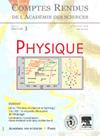系外行星的直接成像:遗产和前景
IF 1.2
4区 物理与天体物理
Q3 ASTRONOMY & ASTROPHYSICS
引用次数: 1
摘要
. 了解巨行星和类地行星是如何形成和演化的,它们的内部结构是什么,它们的大气是什么,是现代天文学的主要挑战之一,这与在2030-2050年地平线上寻找生命的终极目标直接相关。然而,必须克服一些天体物理学(了解巨行星和类地系外行星的形成和物理)、生物学(确定最佳生物标志物)和技术(新一代望远镜和仪器的技术创新)方面的障碍。从天体物理学的角度来看,理解巨行星的形成和演化机制,包括行星和行星盘的相互作用,确实是至关重要的,这将完全塑造行星的结构,从而主宰类地行星的形成,特别是在主星周围能够支持生命的区域。开发专门的仪器和技术来研究巨行星和类地行星的总体数量,而且在不久的将来揭示类地行星大气中生命的第一个生物标志也很重要。从这个角度来看,地面观测站或空间的直接成像与其他观测技术一起发挥着核心作用。在本文中,我将简要回顾这种观测技术的起源,主要的仪器创新和挑战,恒星目标和调查,然后介绍在年轻的巨行星和行星系统结构的物理和机制形成和演化方面获得的主要结果。然后,我将介绍即将到来的令人兴奋的前景本文章由计算机程序翻译,如有差异,请以英文原文为准。
Direct imaging of exoplanets: Legacy and prospects
. Understanding how giant and terrestrial planets form and evolve, what is their internal structure and that of their atmosphere, represents one of the major challenges of modern astronomy, which is directly connected to the ultimate search for life at the horizon 2030–2050. However, several astrophysical (under-standing of the formation and physics of giant and terrestrial exoplanets), biological (identification of the best biomarkers) and technological (technical innovations for the new generations of telescopes and instruments) obstacles must be overcome. From the astrophysical point of view, it is indeed crucial to understand the mechanisms of formation and evolution of giant planets, including planet and disk interactions, which will completely sculpt the planetary architectures and thus dominate the formation of terrestrial planets, es-pecially in regions around the host star capable of supporting life. It is also important to develop dedicated instrumentation and techniques to study in their totality the population of giant and terrestrial planets, but also to reveal in the near future the first biological markers of life in the atmospheres of terrestrial planets. In that perspective, direct imaging from ground-based observatories or in space is playing a central role in concert with other observing techniques. In this paper, I will briefly review the genesis of this observing tech-nique,themaininstrumentalinnovationandchallenges,stellartargetsandsurveys,tothenpresentthemain resultsobtainedsofaraboutthephysicsandthemechanismsofformationandevolutionofyounggiantplan-ets and planetary system architectures. I will then present the exciting perspectives o ff ered by the upcoming
求助全文
通过发布文献求助,成功后即可免费获取论文全文。
去求助
来源期刊

Comptes Rendus Physique
物理-天文与天体物理
CiteScore
2.80
自引率
0.00%
发文量
13
审稿时长
17.2 weeks
期刊介绍:
The Comptes Rendus - Physique are an open acess and peer-reviewed electronic scientific journal publishing original research article. It is one of seven journals published by the Académie des sciences.
Its objective is to enable researchers to quickly share their work with the international scientific community.
The Comptes Rendus - Physique also publish journal articles, thematic issues and articles on the history of the Académie des sciences and its current scientific activity.
From 2020 onwards, the journal''s policy is based on a diamond open access model: no fees are charged to authors to publish or to readers to access articles. Thus, articles are accessible immediately, free of charge and permanently after publication.
The Comptes Rendus - Physique (8 issues per year) cover all fields of physics and astrophysics and propose dossiers. Thanks to this formula, readers of physics and astrophysics will find, in each issue, the presentation of a subject in particularly rapid development. The authors are chosen from among the most active researchers in the field and each file is coordinated by a guest editor, ensuring that the most recent and significant results are taken into account. In order to preserve the historical purpose of the Comptes Rendus, these issues also leave room for the usual notes and clarifications. The articles are written mainly in English.
 求助内容:
求助内容: 应助结果提醒方式:
应助结果提醒方式:


